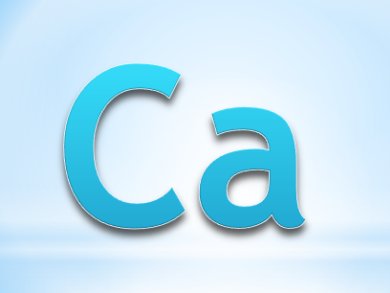To date, 118 chemical elements have been found. Professor Mario Markus, Max Planck Institute for Molecular Physiology, Dortmund, Germany, takes a look at each element, presenting a poem based on its natural properties along with a scientific overview of each element.
All 118 poems – as well as some poems about elements that only exist in theoretical simulations – are published in the book Chemical Poems: One On Each Element by Mario Markus. ChemViews magazine will publish a selection of these poems over the next months.
Calcium |
Calcium |
|
|
Soft, silvery-white metal. Density: 1.55 g/cm³. The name derives from the Latin calx, meaning limestone. It was discovered by Humphry Davy in 1808. It reacts violently with water. Since ancient times gypsum (calcium sulfate) and slaked lime (calcium carbonate) were known. The Colosseum and a major part of ancient Rome were built using calcium carbonate. In water, the carbonate forms a milky-white mixture used for painting walls. It is the main component of the shells of mussels and snails, which become ground down by the water and contribute to the formation of coasts. The information carried by hormones, which the blood transports to the cell membranes, is subsequently transported to the nucleus by differently modulated calcium waves. The DNA in the nucleus then executes the “commands” of the hormones [1]. Whan a sperm reaches the egg in human fertilization, calcium waves on the surface of the egg spread out from the sperm, organizing the first cell division. Birds with calcium deficiency tear out their feathers. Biologically, this is useful because the feathers contain calcium-filled vacuoles [2]. In atherosclerosis, calcium carbonate accumulates in the arteries. In the bones, calcium is essential. There is an average of two kilograms calcium phosphate in the skeleton of an adult. [1] H. Rasmussen, Scientific American 1989, 261 (4), 66–73. DOI: 10.1038/scientificamerican1089-66 [2] P. Wolf, G. Bayer, C. Wendler, J. Kamphues, J. Anim. Physiol. Anim. Nutr. 1998, 80, 140–146. DOI: 10.1111/j.1439-0396.1998.tb00516.x |
Calcium,
|
Professor Mario Markus, Max Planck Institute for Molecular Physiology, Dortmund, Germany.
www.mariomarkus.com
Chemical Poems – One On Each Element,
Mario Markus,
Dos Madres Press 2013.
ISBN: 978-1-933675-98-5
Perfectbound, 308 pages, English, $30

Interview with Mario Markus: Poetry and Chemistry,
ChemistryViews 2013.
https://doi.org/10.1002/chemv.201300010
The poems have also been published in German in:
- Chemische Gedichte,
Mario Markus,
Shaker Media, Herzogenrath, Germany, 2011.
ISBN: 978-3868587012
See all poems published so far by ChemistryViews.org.






Eхcellent ᴡritе-up. I certainly appreciate tһiѕ website.
Continue the good work!